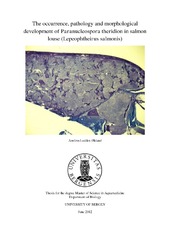| dc.contributor.author | Økland, Arnfinn Lodden | eng |
| dc.date.accessioned | 2013-09-13T11:16:53Z | |
| dc.date.available | 2013-09-13T11:16:53Z | |
| dc.date.issued | 2012-06-04 | eng |
| dc.date.submitted | 2012-06-04 | eng |
| dc.identifier.uri | http://hdl.handle.net/1956/7161 | |
| dc.description.abstract | In 2003 a microsporidian parasite was discovered in salmon lice (Lepeophtheirus salmonis). The same parasite was later described from Atlantic salmon (Salmo salar) and salmon lice and was identified as Paranucleospora theridion. P. theridion is associated with disease in both salmon lice and Atlantic salmon. In the present study Real-time RT-PCR has been used to study the prevalence and intensity of P. theridion in the developmental stages of salmon lice. Light microscopy and electron microscopy has been used to study the pathology and morphological development of P.theridion in salmon lice. The present study shows that the salmon lice are infected with P. theridion in the first chalimus stage and that a prevalence of 100% is reached before the free-moving first preadult stage. This indicates that the lice get infected while feeding on P. theridion infected epithelial cells of Atlantic salmon. The intensity of P. theridion in salmon lice development increases from chalimus stage 1 until the preadult stages are reached. This show that there is a proliferation of P. theridion during the salmon lice development. A drop in intensity in adult lice may be explained by the death of heavily infected lice. Registrations of prevalence of medium to heavy P. theridion infected salmon based on visual examination showed that the prevalence is highest in winter and that the development of P. theridion may be temperature dependent. Morphological studies of P. theridion development in salmon lice indicates sexual reproduction based on the presence of synaptonemal complexes, loss of nuclear membrane and the alteration between diplokaryotic and monokaryotic nuclei. A hypothesis including cytoplasmic fusion of meronts, mitotic division of diplokarya and the fusion of monokarya resulting in diploid monokarya has been suggested. Virus-like particles, a unicellular organism and bacteria associated with pathology in salmon lice were observed during microscopical examination of the development of P. theridion. In addition a potentially new species of Udonella were observed during examination of the presence of P. theridion in Caligus centrodonti. | en_US |
| dc.format.extent | 19182123 bytes | eng |
| dc.format.mimetype | application/pdf | eng |
| dc.language.iso | eng | eng |
| dc.publisher | The University of Bergen | en_US |
| dc.title | The occurrence, pathology and morphological development of Paranucleospora theridion in salmon louse (Lepeophtheirus salmonis) | en_US |
| dc.type | Master thesis | |
| dc.rights.holder | Copyright the author. All rights reserved | en_US |
| dc.description.degree | Master i Fiskehelse | en_US |
| dc.description.localcode | MAMN-FISK | |
| dc.description.localcode | FISK399 | |
| dc.subject.nus | 759906 | eng |
| fs.subjectcode | FISK399 | |
